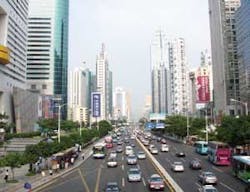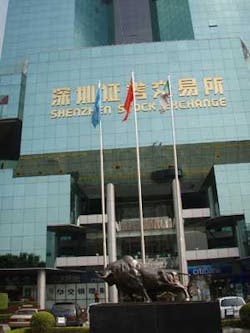Banking on China in energy transactions
Once considered a house of cards, China’s banks have restructured and made a remarkable turnaround in a few short years. After forging global alliances, the banks are reporting record profits each quarter and China’s three biggest banks now rank among the top 20 in the world.
Jim Trippon, CPA Trippon Wealth Management Houston
Only six years ago, China expert Gordon Chang declared that China’s banks were doomed to imminent collapse, an event that would bring the entire Chinese economy to its knees. Chang’s opinion created significant concern in the US energy sector about the reliability of entering into transactions with China. His book on the subject was widely read and entirely wrong.
I have been on record for years predicting the very opposite: that China will experience an unprecedented economic boom, ultimately creating the largest economy in the world. In the process its banks will become worldwide financial giants.
All of this is coming to pass, and it is happening much sooner than one might think. China’s nascent banking and financial system has already begun to reach around the planet, exerting global influence that will inevitably rival America’s greatest investment and retail banks. Citigroup and Goldman Sachs will be obliged to take their place alongside the likes of the Bank of China, the Industrial and Commercial Bank, and China Construction Bank.
How did China’s banks come back from the brink? Only part of the credit goes to the Chinese economy, which has raced ahead of all expectations, growing by double digits every single year since Gordon Chang and a number of other “experts” predicted doom. China is now home to some of the largest financial and corporate entities in the world.
Rescuing China’s banks hasn’t been easy or cheap. The Chinese government has been pouring hundreds of billions of dollars into the nation’s four biggest banks, preparing them for their debut on the world stage. Hard statistics are tough to come by in the secretive Chinese system, but it’s estimated that in excess of $400 billion has been used to rebuild the reserves of the country’s major banks, and the job isn’t over yet.
Back in 1998, the number of non–performing loans on the books of Chinese banks was estimated to make up 50% or more of their assets. China’s banks were an empty shell, and it’s small wonder that foreign observers were alarmed. So–called “policy banks” were nothing more than a funding arm of the Communist regime. They were routinely forced to shovel money into technically bankrupt state–owned enterprises (SOEs) with no hope of repayment.
That had to change. Ever since China’s accession to the World Trade Organization back in 2001, Chinese bankers and bureaucrats have been preparing for 2007 when foreign players would be allowed relatively free access to the country’s banking industry. That meant shutting the doors on thousands of failing state–run companies.
Next, the government had to decide what to do about the teetering mountain of bad loans to SOEs on the books of every bank in the country. There had to be a cleanup. Approximately $400 billion dollars worth of bad debt were shifted to so–called ARCs, asset recovery companies, which were stuck with the job of finding anything worth saving in the financial mess.
The job of preparing China’s banks for their debut on the world stage dwarfs America’s savings and loan industry bailout. More than thirty million Chinese workers lost what they thought were secure government jobs in the country’s economic restructuring. The total cost of the bank bailout has been estimated at more than a quarter of China’s annual GDP.
Long before the restructuring of the banking system was in full swing, foreign retail and investment banks were welcomed into partnerships with China’s ailing giants. To the surprise of some, major players like Bank of America rushed in.
In June of 2005, Bank of America agreed to pay $2.5 billion for a 9% holding in China Construction Bank and to buy $500 million of stock when the Chinese bank went ahead with a planned IPO. It turned out to be the biggest IPO on the planet that year.
For Bank of America it was a spectacularly good deal. China Construction Bank raised $8 billion in its initial public offering in Hong Kong. The offering was 50 times oversubscribed and share values tripled in a matter of weeks. Bank of America now says it made a profit of $30 billion on the deal, more than enough to cover $3 billion in losses from subprime mortgages.
Even more important to Bank of America’s strategic aims, the US banking giant gained access to the vast and still underdeveloped Chinese financial arena through its partnership with the mainland’s third–largest lender.
Despite nagging reports of widespread corruption and cronyism in the Chinese banking system, not to mention the overhang of nonperforming loans, China’s policy banks have proved to be irresistible partners to the banking giants of America.
Citigroup describes China as its number one investment destination. Back in 2003 when the Chinese banking system was still in serious trouble, Citigroup bought a 5% stake in Shanghai Pudong Development Bank and began to introduce credit cards to Chinese consumers.
The Chinese people are traditionally known as habitual savers, and credit cards are still relatively new to them. Now, 18% of China’s retail sales are paid for by credit card. Citigroup’s chief executive for China, Richard Stanley was right when he described his company’s move into China as “one of the greatest opportunities we will ever have.”
Getting in early has proved to be a big advantage. In 2004, HSBC paid $1.75 billion for a 19.9% stake in Bank of Communications, the maximum permitted shareholding in a Chinese bank for a single foreign investor. (Total foreign holdings in Chinese banks may not exceed 25%). HSBC and Goldman Sachs helped organize the highly successful Hong Kong IPO of Bank of Communications, China’s fifth–largest lender.
Global alliances have proven to be a huge plus for Chinese banks and their foreign partners. China’s central bank estimates that Citigroup, HSBC, and other foreign lenders have more than doubled their profits from Chinese banking operations, raking in a combined total of more than half a billion dollars a year.
Foreign investors have invested more than $20 billion in Chinese banks and brokerages. Among the contingent of foreign investors taking a stake in China are Merrill Lynch, Goldman Sachs, the Royal Bank of Scotland, and the Commonwealth Bank of Australia.
But Chinese banks and regulators haven’t allowed foreign firms onto their turf merely to help outsiders profit from China. Even China’s biggest banks and brokerages are still inexperienced and unsophisticated by today’s standards. In addition to capital, foreign investors have been expected to provide management skills, experience with modern lending practices and internationally recognized standards of governance.
Global partnerships have delivered as promised. China’s major banks are now reporting record profits almost every quarter. The ratio of nonperforming loans has been cut sharply. As the government tries to drain liquidity from China’s burgeoning economy, it is strengthening the banks even further by raising their required reserve ratios.
China’s three biggest banks now rank among the top 20 in the world. Last year Industrial & Commercial Bank of China (ICBC) beat Citigroup and Bank of America, becoming the largest bank in the world by market value.
China’s banks have now turned the tables. Flush with cash after huge IPOs in Hong Kong and Shanghai, Chinese banks and financial firms are snapping up bargains overseas. With the plummeting dollar and continuing weakness in American banking stocks in the wake of the subprime mess, US banking giants and financial institutions suddenly look cheap to their Chinese counterparts. China Construction Bank, which once welcomed capital from Bank of America, bought out Bank of America’s investments in Hong Kong and Macau.
China’s largest private lender, Minsheng Bank, purchased a 9.9% stake in San Francisco–based UCBH Holdings in 2007, the first move of its kind by a Chinese bank on American soil. UCBH, which serves the Chinese–American community, received a capital injection of more than $200 million, and Minsheng Bank gained access to the United States, and a partner with considerable expertise in risk management and private banking.
In another milestone move, China’s CITIC Securities invested a billion dollars in Bear Stearns, the US investment bank, which was struggling with the slumping mortgage market. ICBC and China Merchants Bank are waiting impatiently for permission to open branches in the United States. The Chinese government has hinted that ceilings on foreign ownership of Chinese banks will not be lifted until the US relents on the opening of Chinese bank branches in America.
The big picture for China’s banks is very big indeed. China’s Banking Regulatory Commission is pushing banks to seek out mergers and acquisitions around the world. That’s exactly what’s happening. ICBC purchased a 20% stake in South Africa’s Standard Bank for $5.56 billion. In support of China’s push to develop a presence in Africa, China Development Bank has forged a partnership with United Bank for Africa, one of Nigeria’s biggest lenders.
Today it is China that is offering capital and banking services to the world. As an official of the China Banking Regulatory Commission said last October, “We will encourage Chinese banks to go abroad to participate in international competition and overseas acquisitions to improve global competitiveness.”
There are still critics who say that China’s banking system is still a house of cards. But the smart money is betting that Chinese banks are a colossal source of capital. And those who are listening closely realize that yesterday’s banking derelicts are likely to become tomorrow’s fiercest competitors. OGFJ
About the author
Jim Trippon [[email protected]] is the CEO of a financial advisory firm that helps energy executives optimize their personal finances. He is a recognized expert on stock option exercise strategy and managing employer stock concentration risk. Trippon has 23 years’ energy industry experience, including a stint with PricewaterhouseCoopers, where he ran the audits of Exxon and its pension plans. In addition, he has authored the upcoming 2008 title, China Stock Guru, and is rated the #1 China investment expert in the US by the Hulbert Financial Digest. For more information about Trippon or his book, please visit www.ChinaMiracle.com.





